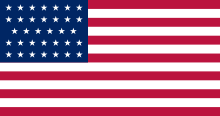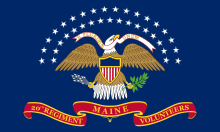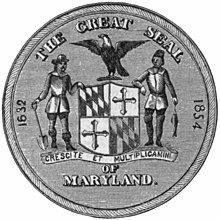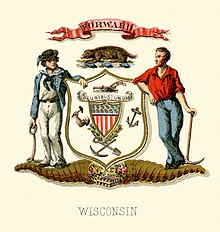Portal:American Civil War/Grand Parade of the States
At the time of the
Even before secession, the governor of Alabama

During the American Civil War, Arkansas was a Confederate state, though it had initially voted to remain in the Union. Following the capture of Fort Sumter in April 1861, Abraham Lincoln called for troops from every Union state to put down the rebellion, and Arkansas and several other states seceded. For the rest of the civil war, Arkansas played a major role in controlling the Mississippi River, a major waterway.
Arkansas raised 48 infantry regiments, 20 artillery batteries, and over 20 cavalry regiments for the Confederacy, mostly serving in the

Arizona Territory, colloquially referred to as Confederate Arizona, was an organized incorporated territory of the Confederate States of America that existed from August 1, 1861, to May 26, 1865, when the Confederate States Army Trans-Mississippi Department, commanded by General Edmund Kirby Smith, surrendered at Shreveport, Louisiana. However, after the Battle of Glorieta Pass, the Confederates had to retreat from the territory, and by July 1862, effective Confederate control of the territory had ended. Delegates to the secession convention had voted in March 1861 to secede from the New Mexico Territory and the Union, and seek to join the Confederacy. It consisted of the portion of the New Mexico Territory south of the 34th parallel, including parts of the modern states of New Mexico and Arizona. The capital was Mesilla, along the southern border. The breakaway region overlapped Arizona Territory, established by the Union government in February 1863.
Arizona was proclaimed a Confederate territory on August 1, 1861, after Colonel
Democrats had dominated the state from its inception, and Southern Democrats were sympathetic to secession. Although they were a minority in the state, they had become a majority in

During the American Civil War (1861–1865), Washington, D.C., the capital city of the United States, was the center of the Union war effort, which rapidly turned it from a small city into a major capital with full civic infrastructure and strong defenses.
The shock of the Union defeat at the

Slavery had been a divisive issue in Delaware for decades before the American Civil War began. Opposition to slavery in Delaware, imported from Quaker-dominated Pennsylvania, led many slaveowners to free their slaves; half of the state's black population was free by 1810, and more than 90% were free by 1860. This trend also led pro-slavery legislators to restrict free black organizations, and the constabulary in Wilmington was accused of harsh enforcement of runaway slave

Florida had by far the smallest population of the Confederate states with about 140,000 residents, nearly half of them enslaved people. As such, Florida sent around 15,000 troops to the Confederate army, the vast majority of which were deployed elsewhere during the war. The state's chief importance was as a source of cattle and other food supplies for the Confederacy, and as an entry and exit location for blockade-runners who used its many bays and small inlets to evade the Union Navy. (Full article...)

Georgia was one of the original seven slave states that formed the Confederate States of America in February 1861, triggering the U.S. Civil War. The state governor, Democrat Joseph E. Brown, wanted locally raised troops to be used only for the defence of Georgia, in defiance of Confederate president Jefferson Davis, who wanted to deploy them on other battlefronts. When the Union blockade prevented Georgia from exporting its plentiful cotton in exchange for key imports, Brown ordered farmers to grow food instead, but the breakdown of transport systems led to desperate shortages.
There was not much fighting in Georgia until September 1863, when Confederates under
The history of Idaho in the American Civil War
The state was energetically led throughout the war by Governor
In addition to President

During the
Most tribal leaders in Indian Territory aligned with the Confederacy. A total of at least 7,860
Indiana experienced significant political strife during the war, especially after
left the state without the authority to collect taxes, Governor Morton acted outside his state's constitutional authority to secure funding through federal and private loans to operate the state government and avert a financial crisis. (
Kentucky was a southern border state of key importance in the American Civil War. It officially declared its neutrality at the beginning of the war, but after a failed attempt by Confederate General Leonidas Polk to take the state of Kentucky for the Confederacy, the legislature petitioned the Union Army for assistance. Though the Confederacy controlled more than half of Kentucky early in the war, after early 1862 Kentucky came largely under U.S. control. In the historiography of the Civil War, Kentucky is treated primarily as a southern border state, with special attention to the social divisions during the secession crisis, invasions and raids, internal violence, sporadic guerrilla warfare, federal-state relations, the ending of slavery, and the return of Confederate veterans. Kentucky was the site of several fierce battles, including Mill Springs and Perryville. It was the arena to such military leaders as Ulysses S. Grant on the Union side, who first encountered serious Confederate gunfire coming from Columbus, Kentucky, and Confederate cavalry leader Nathan Bedford Forrest. Forrest proved to be a scourge to the Union Army in western Kentucky, even making an attack on Paducah. Kentuckian John Hunt Morgan further challenged Union control, as he conducted numerous cavalry raids through the state. (Full article...)

Louisiana declared that it had

As a fervently abolitionist and strongly Republican state, Maine contributed a higher proportion of its citizens to the Union armies than any other, as well as supplying money, equipment and stores. No land battles were fought in Maine. The only episode was the Battle of Portland Harbor (1863) that saw a Confederate raiding party thwarted in its attempt to capture a revenue cutter.
Abraham Lincoln chose Maine's

During the
Because the state bordered the
Michigan made a substantial contribution to the Union during the American Civil War. While the state itself was far removed from the combat theaters of the war, Michigan supplied many troops and several generals, including George Armstrong Custer. When, at the beginning of the war, Michigan was asked to supply no more than one regiment, Governor Austin Blair sent seven. (Full article...)

Mississippi was the second southern state to declare its secession from the United States, doing so on January 9, 1861. It joined with six other southern states to form the Confederacy on February 4, 1861. Mississippi's location along the lengthy Mississippi River made it strategically important to both the Union and the Confederacy; dozens of battles were fought in the state as armies repeatedly clashed near key towns and transportation nodes.
Mississippian troops fought in every major theater of the
The area that eventually became the U.S. state of Montana played little direct role in the American Civil War. The closest the Confederate States Army ever came to the area was New Mexico and eastern Kansas, each over a thousand miles away. There was not even an organized territory using "Montana" until the Montana Territory was created on May 26, 1864, three years after the Battle of Fort Sumter. In 1861, the area was divided between the Dakota Territory and the Washington Territory, and in 1863, it was part of the Idaho Territory.
Nevertheless,
New Hampshire was a member of the Union during the American Civil War. The state gave soldiers, money, and supplies to the Union Army. It sent 31,657 enlisted men and 836 officers, of whom about 20% were killed in action or died from disease or accident. (Full article...)
The state of New Jersey in the United States provided a source of troops, equipment and leaders for the Union during the American Civil War. Though no major battles were fought in New Jersey, soldiers and volunteers from New Jersey played an important part in the war, including Philip Kearny and George B. McClellan, who led the Army of the Potomac early in the Civil War and unsuccessfully ran for President of the United States in 1864 against his former commander-in-chief, Abraham Lincoln. (Full article...)

The
In 1861, the Confederacy claimed the southern half of the vast New Mexico Territory as its own

The state of New York during the American Civil War was a major influence in national politics, the Union war effort, and the media coverage of the war. New York was the most populous state in the Union during the Civil War, and provided more troops to the U.S. army than any other state, as well as several significant military commanders and leaders. New York sent 400,000 men to the armed forces during the war. 22,000 soldiers died from combat wounds; 30,000 died from disease or accidents; 36 were executed. The state government spent $38 million on the war effort; counties, cities and towns spent another $111 million, especially for recruiting bonuses.
The voters were sharply divided politically. A significant anti-war movement emerged, particularly in the mid- to late-war years. The Democrats were divided between War Democrats who supported the war and Copperheads who wanted an early peace. Republicans divided between moderates who supported Lincoln, and Radical Republicans who demanded harsh treatment of the rebel states. New York provided William H. Seward as Lincoln's Secretary of State, as well as several important voices in Congress. (Full article...)

During the
Fighting occurred sporadically in the state from September 1861, when Union

At the outbreak of the
Oregon's second United States Senator, Col.
The state of Rhode Island during the American Civil War remained loyal to the Union, as did the other states of New England. Rhode Island furnished 25,236 fighting men to the Union Army, of which 1,685 died. The state used its industrial capacity to supply the Union Army with the materials needed to win the war. Rhode Island's continued growth and modernization led to the creation of an urban mass transit system and improved health and sanitation programs. (Full article...)


The American Civil War significantly affected Tennessee, with every county witnessing combat. During the War, Tennessee was a Confederate state, and the last state to officially secede from the Union to join the Confederacy. Tennessee had been threatening to secede since before the Confederacy was even formed, but didn’t officially do so until after the fall of Fort Sumter when public opinion throughout the state drastically shifted. Tennessee seceded in protest to President Lincoln's April 15 Proclamation calling forth 75,000 members of state militias to suppress the rebellion. Although Tennessee provided a large number of troops for the Confederacy, it would also provide more soldiers for the Union Army than any other state within the Confederacy.
In February 1862, some of the war's first serious fighting took place along the

By the spring of 1865 Vermont was devastated, having sent one tenth of its entire population to war, with a loss of over 5,000 lives to battle, wounds, and disease. The state had dedicated nearly $10 million to support the conflict, half of that amount offered up by towns with no expectation of recompense.

The American state of Virginia became a prominent part of the Confederacy when it joined during the American Civil War. As a Southern slave-holding state, Virginia held the state convention to deal with the secession crisis and voted against secession on April 4, 1861. Opinion shifted after the Battle of Fort Sumter on April 12, and April 15, when U.S. President Abraham Lincoln called for troops from all states still in the Union to put down the rebellion. For all practical purposes, Virginia joined the Confederacy on April 17, though secession was not officially ratified until May 23. A Unionist government was established in Wheeling and the new state of West Virginia was created by an act of Congress from 50 counties of western Virginia, making it the only state to lose territory as a consequence of the war. Unionism was indeed strong also in other parts of the State, and during the war the Restored Government of Virginia was created as rival to the Confederate Government of Virginia, making it one of the states to have 2 governments during the Civil War.
In May, it was decided to move the Confederate capital from

The role of
The U.S. state of West Virginia was formed out of western Virginia and added to the Union as a direct result of the American Civil War (see History of West Virginia), in which it became the only modern state to have declared its independence from the Confederacy. In the summer of 1861, Union troops, which included a number of newly formed Western Virginia regiments, under General George McClellan drove off Confederate troops under General Robert E. Lee at the Battle of Philippi in Barbour County. This essentially freed Unionists in the northwestern counties of Virginia to form a functioning government of their own as a result of the Wheeling Convention. Before the admission of West Virginia as a state, the government in Wheeling formally claimed jurisdiction over all of Virginia, although from its creation it was firmly committed to the formation of a separate state.
After Lee's departure, western Virginia continued to be a target of Confederate raids. Both the Confederate and state governments in Richmond refused to recognize the creation of the new state in 1863, and thus for the duration of the war the Confederacy regarded its own military offensives within West Virginia not as invasion but rather as an effort to liberate what it considered to be enemy-occupied territory administered by an illegitimate government in Wheeling. Nevertheless, due to its increasingly precarious military position and desperate shortage of resources, Confederate military actions in what it continued to regard as "western Virginia" focused less on reconquest as opposed to both on supplying the Confederate Army with provisions as well as attacking the vital

With the outbreak of the


